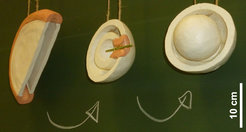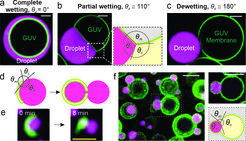Dynamics of Bio-Membranes
Intracellular compartmentalization is a hallmark of eukaryotic cells that facilitates the spatial organization of metabolic and regulatory processes. Membranes demarcate compartments in cells, thereby acting as key structural components that define the internal organization of the cell. I study membrane material properties, composition, functions and morphologies to gain a better understanding of intracellular compartmentalization. In my research, I aim to understand the complex dynamics of biological membranes, with a focus on autophagosome formation (Fig. 1), a key event in a key intracellular recycling pathway called autophagy (Knorr et al. Plos One 2012 and 2014, Autophagy 2015, Traffic 2017, Methods Mol Biol 2019, Nature2 and iScience 2020).

Fig. 1: 3D models of an intermediate step of autophagosome formation
Recently, phase-separated membrane-less compartments (‘droplets’) have garnered much attention in biological and soft matter research. Such droplets are now understood to play an important role in intracellular organization (Nature 2020). While contacts between these droplets and membranes were first imaged half a century ago, virtually no progress has been made in elucidating the forces that underlie these contacts. This is in spite of the many potential applications of membrane-droplet interactions in basic and applied research, including medicine and agriculture.
My recent work addresses this important question of droplet-membrane contacts, focusing on the physical principles that underlie droplet-membrane interactions. These studies have revealed that wetting mediates mutual remodeling of protein-rich droplets and membranes, as shown in Fig. 2a-c. It is known that such droplets are degraded by autophagy in cells. I describe how physical forces govern complex droplet-membrane morphological changes during droplet autophagy that cannot be explained by conventional cellular regulatory mechanisms, such as protein machineries (Fig. 2d,e; Nature 2020, Nature in press). In addition to autophagosome morphogenesis, I have also studied the formation of protein storage vacuoles which develop during plant embryogenesis (Fig. 2f). Through this work, I uncover physical mechanisms that address the long-standing biological question of how organelles form in cells.
This cutting-edge research draws on a talented network of scientists and combines concepts and methods from biophysics, biochemistry, cell biology and interfacial sciences. I collaborate with leading researchers from around the world to devise theoretical models that we confirm by in vitro and in vivo experimentation on a very broad range of model organisms, including yeast, mammalian cells, plant embryos, and reconstituted minimalistic systems. Our work is consistently published in leading journals.

Proteinaceous droplets wet and remodel membranes in vitro and in vivo. a-c In vitro reconstituted droplets can form three distinct wetting states on membranes. We observe mutual droplet-membrane remodeling in the partial wetting state. d Droplet autophagy morphologies predicted by our theoretical model. e Live-cell imaging of droplet autophagy confirmed piecemeal degradation, as predicted by our model. f Confocal images of a live Arabidopsis thaliana plant embryo showing that wetting droplets reshape vacuole membranes. Scale bars, 5 µm (white), 2 µm (yellow). Contact angles are indicated.

